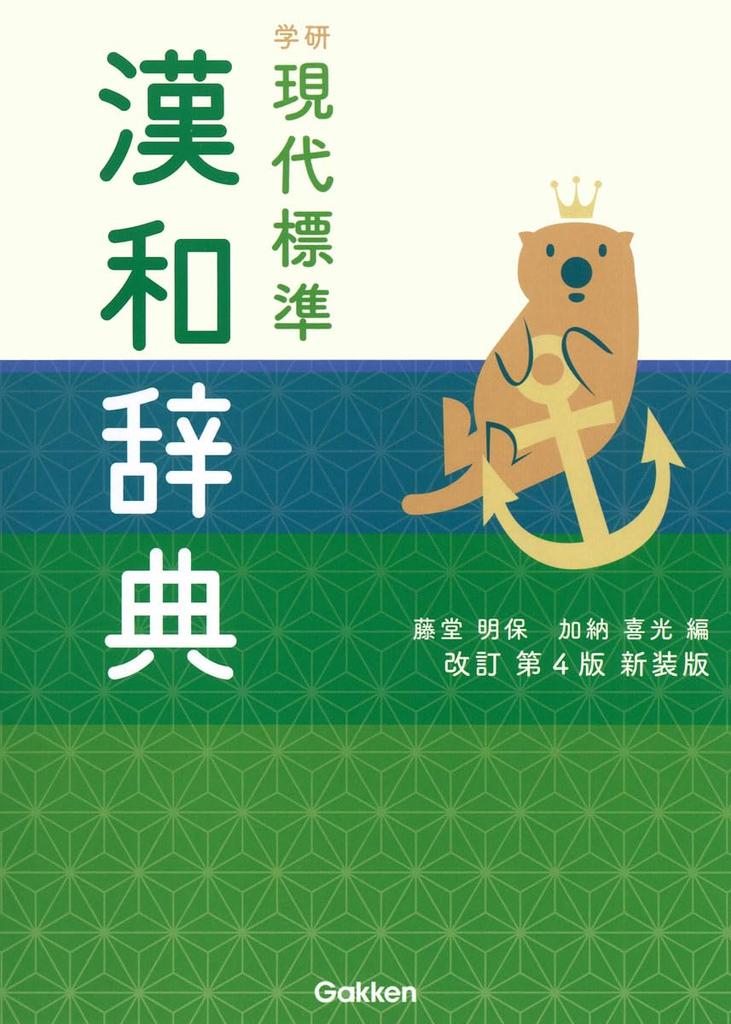★An easy-to-read, easy-to-understand, and easy-to-use dictionary.
★The kanji and vocabulary included make this dictionary perfect for junior high school students.
★The character is a sea otter.
This Chinese-Japanese dictionary supports the new curriculum guidelines for "thinking, judgment, and expression," improving kanji and vocabulary skills and honing expression. It's designed for junior high school study. It can be used from junior high school entrance exams through high school entrance exams.
Four Major Features!!
1. Develops kanji skills
2. Develops vocabulary and expression skills
3. Designed for junior high school study
4. Easy-to-use index
1. Kanji skills
(1) 20 new kanji characters taught in elementary school and changes to grade assignments. Use with confidence.
(2) For common kanji, the on-yomi (reading)/kun-yomi (reading) symbols that are designated for elementary, junior high, and high school study are marked with (ko), (chu), or (ko). It's clear at a glance when and what to memorize.
(3) Contains 7,556 kanji and 25,000 compound words. Ensures sufficient quality.
(4) Stroke order for all kanji learned in elementary school is displayed on all frames. You can write without hesitation.
(5) The origins of kanji are listed in six forms, including pictographic, indicative, compound, and phono-semantic, with sharp explanations. Interesting and easy to understand.
2 Vocabulary and Expression Skills
(6) Among the examples of kanji meanings and compound words, the [Word] mark is displayed for four-character idioms, historical allusions, proverbs, idiomatic phrases, collocations, set phrases, and idiomatic expressions. This is useful for improving writing.
(7) The usage patterns correspond to the Agency for Cultural Affairs' report on "Examples of Different Characters with the Same Reading." You can decide how to use the kanji.
(8) The headings of compound words are marked with [Four-Character Idioms] and [Historical Allusions], and can be looked up in the index. This is useful for research study.
3 Suitable for junior high school studies
(9) The main columns on classical Chinese and Chinese poetry feature plain text, kunten (Japanese reading), written Japanese, and modern Japanese translations. Each Chinese poem includes an appreciation section and author introductions. This makes studying classical Chinese easy.
(10) The last page includes "How to Use the Book for Research" (Japanese dictionary, Kanji dictionary, archaic Japanese dictionary, other dictionaries, encyclopedias, and illustrated books). Knowing how to research is reassuring.
4 Index and "Opinion Poll"
(11) The index is user-friendly and easy to use.
- The on-kun (Japanese reading) index includes a list of the 50 syllables on the side of the page. This helps you find your current location.
- The total stroke index includes a list of the total number of strokes on the side of the page. This helps you find your current location.
- Other useful features include a radical index, a column on the topics surrounding kanji numerals, a column on how to differentiate their usage, a four-character idiom index, a historical idiom index, a column on classical Chinese and written Japanese, and a column on classical Chinese poetry and written Japanese.
(12) Contains the results of the Agency for Cultural Affairs' "Public Opinion Poll on the National Language." You can check the current state of language in Japan with numerical data. You'll be able to use the language with confidence.
The main target audience is junior high school students, but adults can also use it.
Includes special bonuses exclusive to the new edition.






























